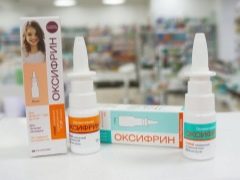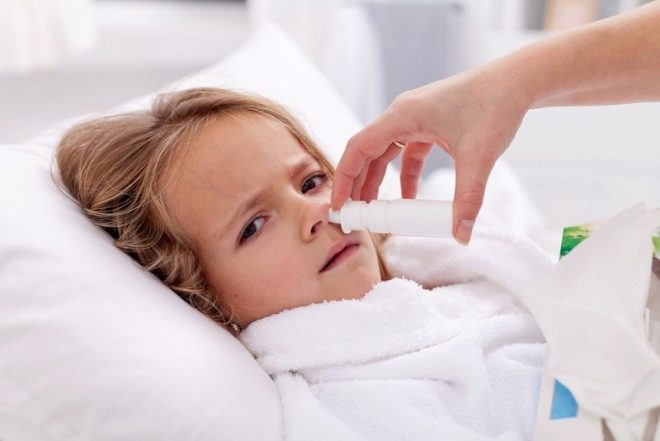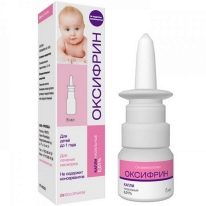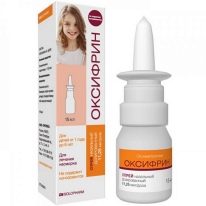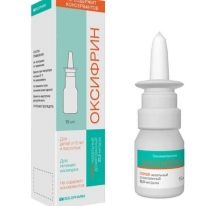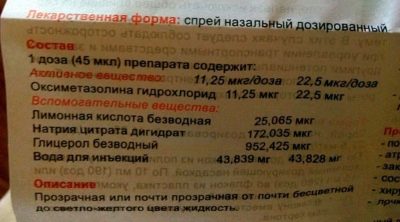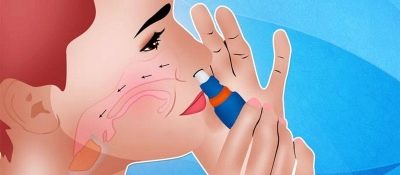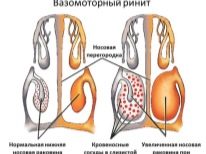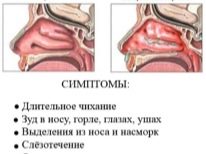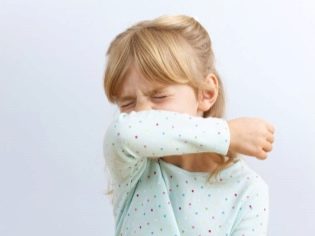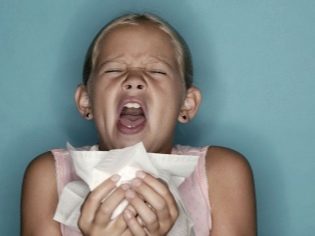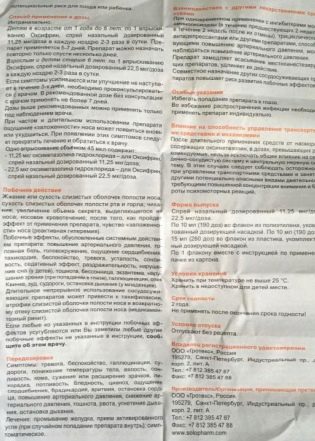Spray "Oksifrin" for children
Oxymetazoline-based drugs are often prescribed for the common cold, as they effectively cope with nasal congestion and copious secretions. One of them is a drug from the company Solopharm called "Oxyfrin".
Application features
For the youngest babies, it is produced in drops, allowed for use even in infants up to a year. Older children are discharged spray. It is a clear liquid, which has a yellowish tint. One spray package contains 10 or 15 ml of solution, which corresponds to 190 or 280 doses.
Unlike analogs, this drug does not contain preservatives and does not desiccate the nasopharynx. In addition, it has a very fast and long-lasting effect, since the effect is observed, already a few minutes after spraying, and it lasts up to 12 hours. Another advantage of this medicine can be called a special structure of the nozzle. It not only allows you to accurately dose the solution and irrigate the entire surface of the nasal passage from the inside, but also makes it possible to apply the medicine in any position (the baby can sit and lie). In addition, the nozzle is reliably protected from the ingress of bacteria inside, so one bottle can be used immediately by several people.
Composition
The therapeutic effect of "Oxyphrine", as noted above, causes oxymetazoline. This substance in the form of hydrochloride is contained in a solution in the amount of 11.25 or 22.5 mcg in one dose. A less concentrated drug is allowed to be used for children from 1 year to 6 years, and the drug with a higher concentration is prescribed from the age of six. Additionally, the solution contains citric acid, anhydrous glycerol, sterile water, and sodium citrate.
Operating principle
After getting oxymetazoline on the mucous membrane of the nasal passages, this substance stimulates adrenergic receptors of the "alpha" type. There are many such receptors in the vessels, therefore, the stimulating effect causes a vasoconstrictor effect. Thanks to him, after irrigation of the nasopharynx, the swelling decreases and the amount of nasal discharge decreases, which causes the restoration of nasal breathing.
In addition, a consequence of vasoconstriction under the influence of oxymetazoline will also be the restoration of the patency of the paranasal sinuses and Eustachian tubes, which helps in the treatment of the inflammatory process in these organs, and also does not allow such complications as sinusitis, otitis media, sinusitis or eustachitis. The presence of glycerol in the composition of the drug helps to further moisturize the mucous membrane and protect the nasopharynx from drying out, which also helps to eliminate irritation.
Indications
Most often, “Oxyphrine” is prescribed for acute respiratory diseases, which manifest as a head cold. Another drug is used in such types of rhinitis as vasomotor and allergic. It may be included in the complex treatment of sinusitis and otitis, as well as eustachitis.
One more reason to prescribe “Oxyfrin” to a child can be called diagnostic or therapeutic manipulations on the nasal passages - a sprinkle is used to facilitate the doctor's execution of the procedure.
Contraindications
“Oxyphrine” is not used in case of hypersensitivity to oxymetazoline or to any inactive component of the solution. Spray should not be used in the case of dry rhinitis, which is also called atrophic.The drug is contraindicated in patients with angle-closure glaucoma, as well as those who have undergone surgery on the meninges or the pituitary gland in the past. In adults, it is not used during pregnancy and breastfeeding.
In addition, there are quite a few relative contraindications, in which the question of treatment with Oxyfrin is solved individually. These include hyperthyroidism, heart disease, renal failure, diabetes mellitus, porphyria and other pathologies.
Therefore, if the child has any diseases, this should be reported to the doctor before starting treatment.
Side effects
If you use a spray in children at a therapeutic dose, then redness and irritation usually do not occur, as well as addiction. However, some children still respond to "oxyfrin" with side effects such as congestion, flushing, itching, burning, frequent sneezing, dryness in the nose, and so on. They are often found with excessive irrigation or in the case of more prolonged use than prescribed by the doctor.
Occasionally, the medicine can also cause symptoms that are related to systemic effects, such as tachycardia, anxiety, drowsiness, headache, sleep problems, or nausea.
In case of such illnesses, you should stop using Oxyphrine and contact a specialist.
Instructions for use
Having chosen a suitable age spray, it is used as follows:
- medicine should be sprayed in the nasal cavity twice or thrice a day;
- a single dosage will be one injection for one nostril (in some cases, the doctor may prescribe higher doses, but this treatment is carried out only under control);
- the duration of treatment is usually 5-7 days;
- Oxyfrin is not used for more than seven days in a row (if you need to continue the treatment, it is agreed with the doctor and you must take a break for several days);
- if within three days from the start of therapy no improvement is visible or the symptoms become more pronounced, a medical examination is required.
Overdose and drug interactions
A higher dose of “Oxyphrine” can cause restlessness and anxiety, hallucinations, drowsiness, pallor, bradycardia, nausea and other negative symptoms. For the treatment of overdose using gastric lavage and sorbents (if the drug was accidentally swallowed), as well as symptomatic agents.
"Oxyphrine" is incompatible with drugs that inhibit monoamine oxidase. It should not be applied simultaneously with them, or 2 weeks after their cancellation. It should also not be used with drugs that increase blood pressure.
If you assign "Oxyphrine" together with other vasoconstrictor drugs, it will increase the risk of side effects. When used simultaneously with local anesthetics, their analgesic effect will last longer.
Terms of sale and storage
It is very easy to buy “Oxyphrine” at the pharmacy, because it is a non-prescription medication, but when treating a child, a preliminary examination by a doctor is desirable. The average price of a spray for children 1-6 years old is 160 rubles, and for a medicine with a higher concentration, which is prescribed for six-year-old patients and older, you need to pay about 150 rubles.
Store medicines at home should be at a temperature of up to +25 degrees, putting the bottle in the place hidden from the kids. Spray shelf life is 2 years.
Reviews
Most of the reviews about the oxyfrin spray are positive. Advantages of drugs include the absence of preservatives in its composition and quick action. According to moms, the drug is not bitter, it is easily sprayed and can be used by all family members (with the exception of children under one year old who are prescribed drops).
However, sometimes it provokes side effects, which is why parents leave negative feedback.
Analogs
If for some reason it is not possible to use Oxyphrine, another drug that acts on the vessels of the nasal cavity due to Oxymetazoline can replace it.
It may be:
- «Afrin»;
- Nazivin;
- "Nazol";
- Sialor Rino;
- Knoxprey;
- Nazivin Sensitive;
- "Nesopin";
- "Afrin Extra";
- "Nasosprey."
Such drugs are released in drops and sprays, and the concentration of the solution affects the age frame, for example, 0.01% funds are allowed for infants, and 0.05% are prescribed for children who are already 6 years old. In case of hypersensitivity to oxymetazoline, instead of “oxyfrina”, vasoconstrictive drugs with another active substance can be used, for example, «Xylen"," Tizin ","Sanorin" or "Nazol Baby».
Review of the nose spray Oxyphrine see in the next video.
